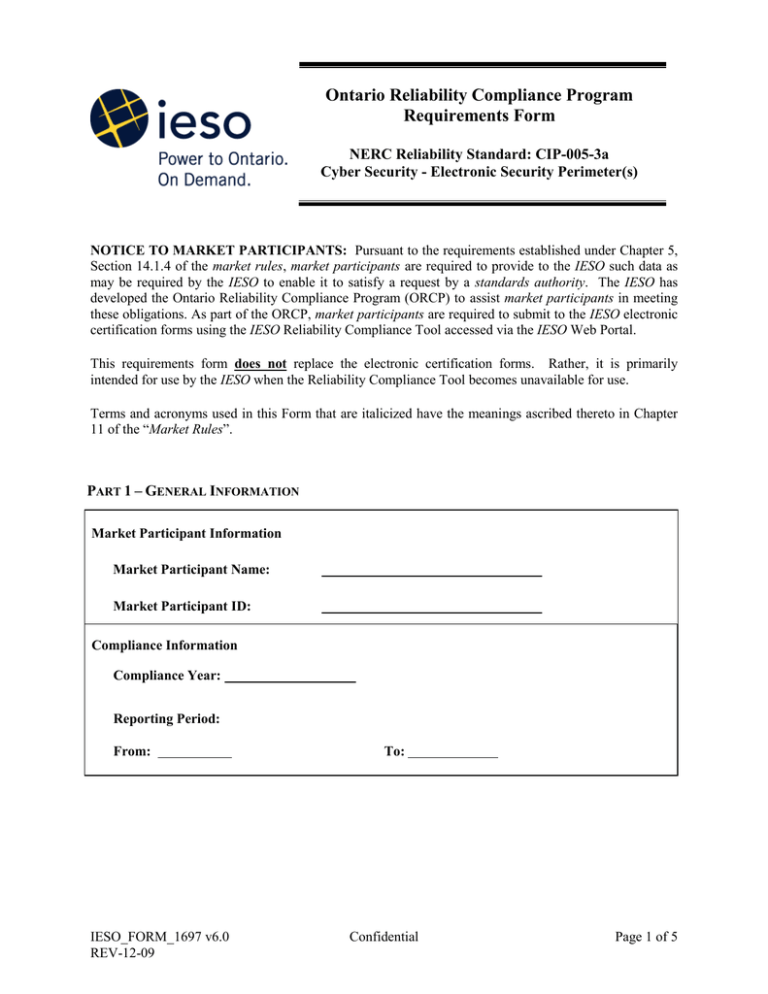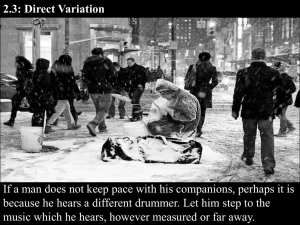Ontario Reliability Compliance Program Requirements Form NERC Reliability Standard: CIP-005-3a
advertisement

Ontario Reliability Compliance Program Requirements Form NERC Reliability Standard: CIP-005-3a Cyber Security - Electronic Security Perimeter(s) NOTICE TO MARKET PARTICIPANTS: Pursuant to the requirements established under Chapter 5, Section 14.1.4 of the market rules, market participants are required to provide to the IESO such data as may be required by the IESO to enable it to satisfy a request by a standards authority. The IESO has developed the Ontario Reliability Compliance Program (ORCP) to assist market participants in meeting these obligations. As part of the ORCP, market participants are required to submit to the IESO electronic certification forms using the IESO Reliability Compliance Tool accessed via the IESO Web Portal. This requirements form does not replace the electronic certification forms. Rather, it is primarily intended for use by the IESO when the Reliability Compliance Tool becomes unavailable for use. Terms and acronyms used in this Form that are italicized have the meanings ascribed thereto in Chapter 11 of the “Market Rules”. PART 1 – GENERAL INFORMATION Market Participant Information Market Participant Name: Market Participant ID: Compliance Information Compliance Year: Reporting Period: From: IESO_FORM_1697 v6.0 REV-12-09 To: Confidential Page 1 of 5 PART 2 – MARKET PARTICIPANT COMPLIANCE REPORTING As an authorized representative of the market participant, I certify that the market participant was: COMPLIANT with the requirements of IESO-FORM-1697 stated below for the entire Reporting Period. Comments: NON-COMPLIANT for a portion of or the entire Reporting Period with some or all requirement(s) of IESO-FORM-1697, but in compliance with all other applicable requirements of IESO-FORM-1697 for the entire Reporting Period, as indicated below. R1. Electronic Security Perimeter - The Responsible Entity shall ensure that every Critical Cyber Asset resides within an Electronic Security Perimeter. The Responsible Entity shall identify and document the Electronic Security Perimeter(s) and all access points to the perimeter(s). R1.1. Access points to the Electronic Security Perimeter(s) shall include any externally connected communication end point (for example, dial-up modems) terminating at any device within the Electronic Security Perimeter(s). R1.2. For a dial-up accessible Critical Cyber Asset that uses a non-routable protocol, the Responsible Entity shall define an Electronic Security Perimeter for that single access point at the dial-up device. R1.3. Communication links connecting discrete Electronic Security Perimeters shall not be considered part of the Electronic Security Perimeter. However, end points of these communication links within the Electronic Security Perimeter(s) shall be considered access points to the Electronic Security Perimeter(s). R1.4. Any non-critical Cyber Asset within a defined Electronic Security Perimeter shall be identified and protected pursuant to the requirements of Standard CIP-005-3. R1.5. Cyber Assets used in the access control and/or monitoring of the Electronic Security Perimeter(s) shall be afforded the protective measures as a specified in Standard CIP-003-3; Standard CIP-004-3 Requirement R3; Standard CIP-005-3 Requirements R2 and R3; Standard CIP-006-3 Requirement R3; Standard CIP-007-3 Requirements R1 and R3 through R9; Standard CIP-008-3; and Standard CIP-009-3. R1.6. The Responsible Entity shall maintain documentation of Electronic Security Perimeter(s), all interconnected Critical and non-critical Cyber Assets within the Electronic Security Perimeter(s), all electronic access points to the Electronic Security Perimeter(s) and the Cyber Assets deployed for the access control and monitoring of these access points. IESO_FORM_1697 v6.0 REV-12-09 Confidential Page 2 of 5 R2. Electronic Access Controls - The Responsible Entity shall implement and document the organizational processes and technical and procedural mechanisms for control of electronic access at all electronic access points to the Electronic Security Perimeter(s). R2.1. These processes and mechanisms shall use an access control model that denies access by default, such that explicit access permissions must be specified. R2.2. At all access points to the Electronic Security Perimeter(s), the Responsible Entity shall enable only ports and services required for operations and for monitoring Cyber Assets within the Electronic Security Perimeter, and shall document, individually or by specified grouping, the configuration of those ports and services. R2.3. The Responsible Entity shall implement and maintain a procedure for securing dial-up access to the Electronic Security Perimeter(s). R2.4. Where external interactive access into the Electronic Security Perimeter has been enabled, the Responsible Entity shall implement strong procedural or technical controls at the access points to ensure authenticity of the accessing party, where technically feasible. R2.5. The required documentation shall, at least, identify and describe: R2.6. R2.5.1. The processes for access request and authorization. R2.5.2. The authentication methods. R2.5.3 The review process for authorization rights, in accordance with Standard CIP-004-3 Requirement R4. R2.5.4. The controls used to secure dial-up accessible connections. Appropriate Use Banner —Where technically feasible, electronic access control devices shall display an appropriate use banner on the user screen upon all interactive access attempts. The Responsible Entity shall maintain a document identifying the content of the banner. R3. Monitoring Electronic Access - The Responsible Entity shall implement and document an electronic or manual process(es) for monitoring and logging access at access points to the Electronic Security Perimeter(s) twenty-four hours a day, seven days a week. R3.1. For dial-up accessible Critical Cyber Assets that use non-routable protocols, the Responsible Entity shall implement and document monitoring process(es) at each access point to the dial-up device, where technically feasible. R3.2. Where technically feasible, the security monitoring process(es) shall detect and alert for attempts at or actual unauthorized accesses. These alerts shall provide for appropriate notification to designated response personnel. Where alerting is not technically feasible, the Responsible Entity shall review or otherwise assess access logs for attempts at or actual unauthorized accesses at least every ninety calendar days. R4. Cyber Vulnerability Assessment - The Responsible Entity shall perform a cyber vulnerability assessment of the electronic access points to the Electronic Security Perimeter(s) at least annually. The vulnerability assessment shall include, at a minimum, the following: IESO_FORM_1697 v6.0 REV-12-09 Confidential Page 3 of 5 R4.1. A document identifying the vulnerability assessment process; R4.2. A review to verify that only ports and services required for operations at these access points are enabled; R4.3. The discovery of all access points to the Electronic Security Perimeter; R4.4. A review of controls for default accounts, passwords, and network management community strings; R4.5. Documentation of the results of the assessment, the action plan to remediate or mitigate vulnerabilities identified in the assessment, and the execution status of that action plan. R5. Documentation Review and Maintenance - The Responsible Entity shall review, update and maintain all documentation to support compliance with the requirements of Standard CIP-005-3 R5.1. The Responsible Entity shall ensure that all documentation required by Standard CIP-005-3 reflect current configurations and processes and shall review the documents and procedures referenced in Standard CIP-005-3 at least annually. R5.2. The Responsible Entity shall update the documentation to reflect the modification of the network or controls within ninety calendar days of the change. R5.3. The Responsible Entity shall retain electronic access logs for at least ninety calendar days. Logs related to reportable incidents shall be kept in accordance with the requirements of Standard CIP-008-3. Comments: N/A – the requirements of IESO-FORM-1697 do not apply to the market participant. Comments: REFERENCE DOCUMENT(S) NERC Reliability Standard - CIP-005-3a IESO_FORM_1697 v6.0 REV-12-09 Confidential Page 4 of 5 SIGNATURE I have full authority to bind the market participant. I certify that all information set out or referred to in this form is true, accurate and complete as at the date of this certification. I further understand that this information is provided in accordance with the requirements of Chapter 5, Section 14.1.1 of the market rules. I understand that this information is subject to verification by the IESO and that such a review or audit will require all information set out or referred to in this form be verified by appropriate documentation. Certified by MPCC1: Please Print Name Signature Date of Certification: 1 market participant compliance contact IESO_FORM_1697 v6.0 REV-12-09 Confidential Page 5 of 5
